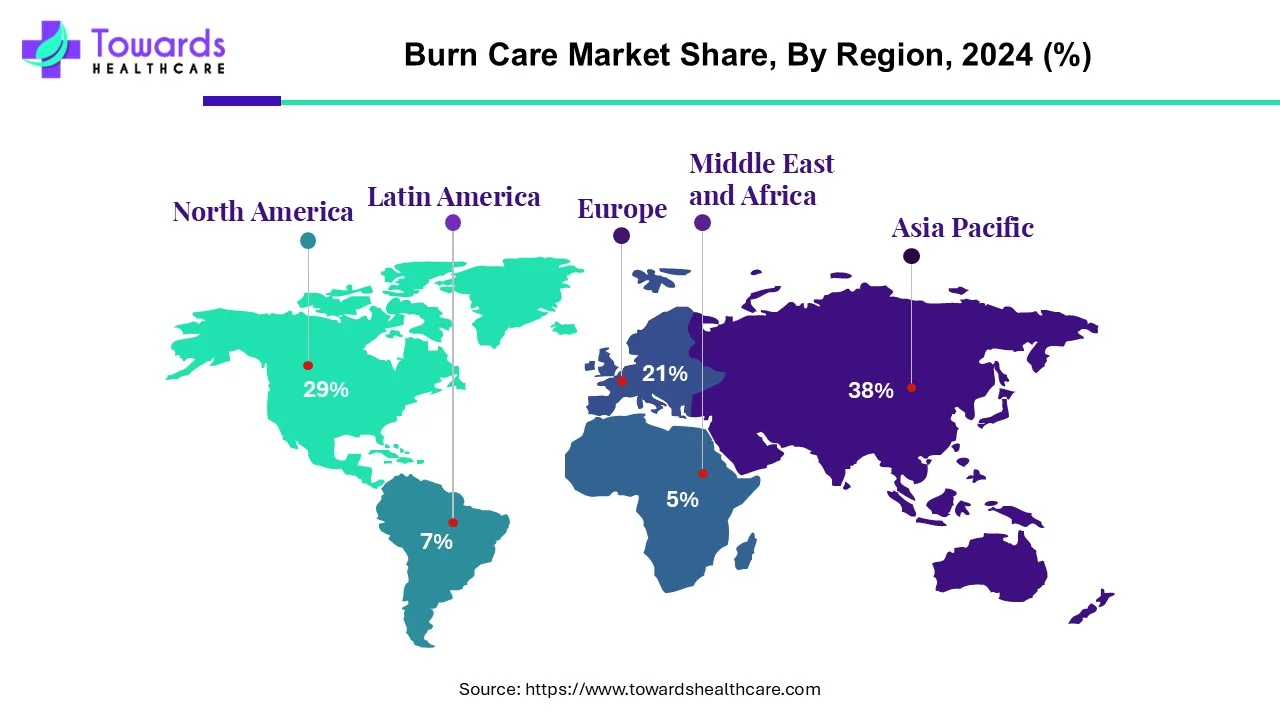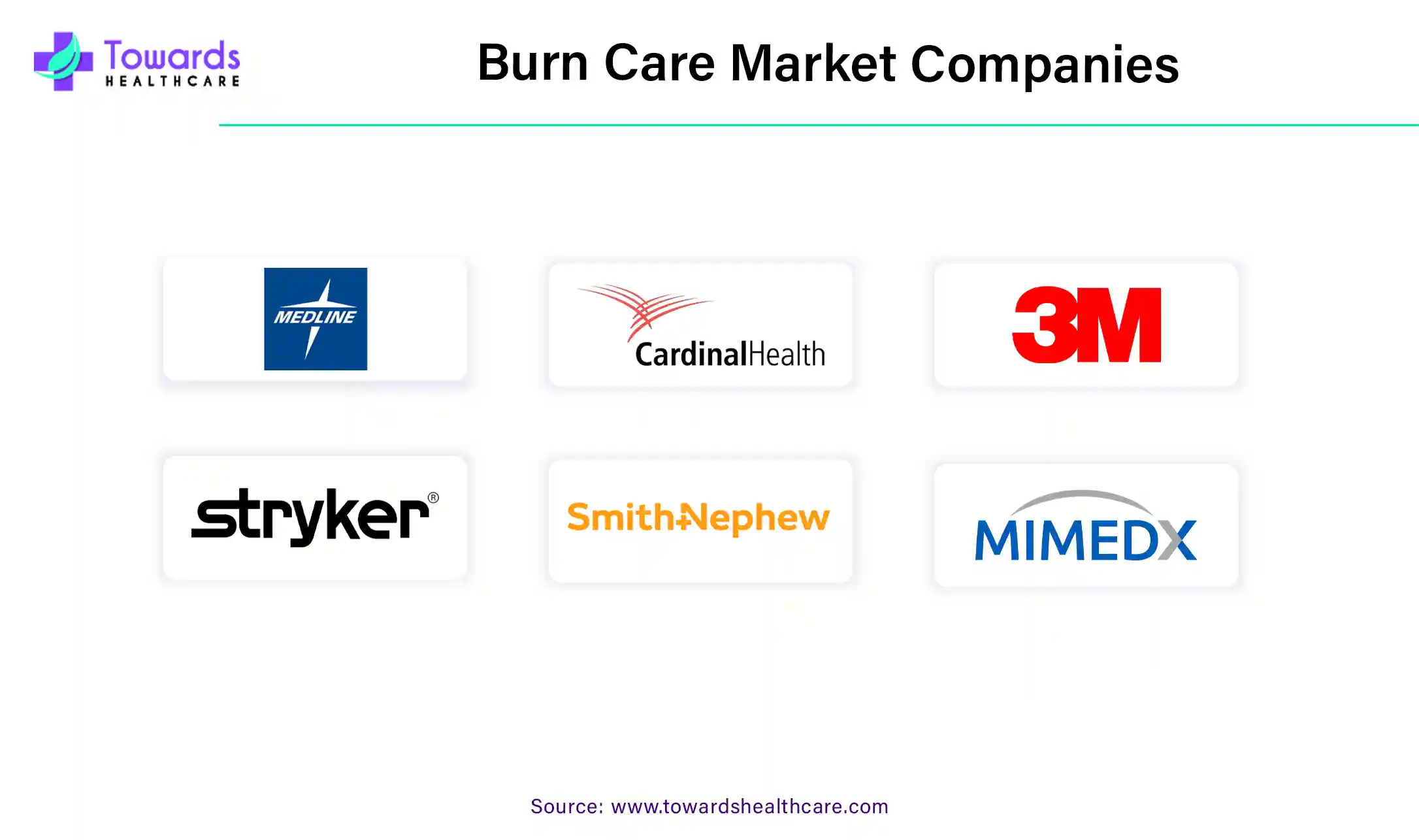April 2025

The burn care market size is projected to reach USD 5.81 billion by 2034, growing from USD 3.13 billion in 2025, at a CAGR of 7.1% during the forecast period from 2025 to 2034.

According to the World Health Organization, every year, 180000 deaths are caused globally by burns, which results in the focus on research and innovative burn care treatment.
In the U.S., over 500,000 people get treatment for burn injuries and serious skin wounds each year! Doctors often have to do surgery, taking skin from one part of the body to patch up severe wounds. But it's a challenging process, and some patients need more skin for grafting. NIH-funded scientists have found that using a cool skin bioprinter might be a great alternative. They tested it on animals, and it worked well, showing that this technology can create a skin that looks and acts like the real deal. While it hasn't been tried on people yet, it's an exciting step toward healing serious skin wounds more easily.
Burn care is all about taking care of injuries caused by burns, ranging from minor to serious. When you get a burn, whether it's from hot objects, chemicals, or fire, it can damage your skin and sometimes even deeper tissues. For minor burns, like a sunburn or a slight kitchen mishap, you can usually handle it with cool water, over-the-counter creams, and a bit of TLC. But when we're talking about more severe burns, that's when the pros step in. Doctors might need to perform surgeries, especially for severe burns. This could involve grafting, where they take skin from one part of your body and use it to cover the burn. However, this process can be intense, and only some have enough skin for grafting. Here's where things get interesting. Scientists are exploring a futuristic approach using something called a skin bioprinter. So, burn care is this blend of traditional methods and innovative tech, all aimed at helping people heal from burns and severe skin injuries. It's a fascinating field that keeps evolving to make the process smoother and more effective. The significant increase in the market is partly due to the severe health risks associated with burn cases.
According to the American Burn Association (ABA), burn injuries account for more than 60% of all hospital admissions for immediate care in the United States. Additionally, the growing demand for less invasive methods of treating burns is expected to drive market growth. The rise in burn injuries and related deaths is a significant factor driving the global burn care market. Because of the large number of burn injuries and deaths, there is an increasing demand for burn treatment products.

Burns are the 4th most common type of trauma globally, following crashes in traffic, falls, and interpersonal violence. Every year, more than five million patients seek medical treatment for burns, resulting in an estimated 180,000 deaths worldwide. These incidents are primarily concentrated in low-income and middle-income countries, particularly South-East Asia, including India, Bangladesh and Nepal. The growing demand for burn care treatments is expected to drive the expansion of the global burn care market in the coming years.
Advanced dressings have opened up exciting opportunities in the burn care market. These next-gen dressings go beyond the basic bandage by incorporating innovative materials and technologies designed to enhance the healing process for burn patients. These dressings often provide better moisture management, creating an optimal environment for wound healing. Some are infused with substances that promote tissue regeneration or have antimicrobial properties to prevent infections. Advanced dressings can contribute to faster recovery, reduced pain, and improved overall outcomes for burn patients.

Additionally, these dressings are designed with patient comfort in mind, offering flexibility and ease of application. Their evolving features align with the healthcare industry's commitment to enhancing patient experience and outcomes. For companies in the burn care market, embracing and developing these advanced dressings presents a chance to stand out and cater to the evolving needs of healthcare providers and patients. It contributes to improved treatment and positions them at the forefront of innovation in burn care, fostering growth opportunities in the dynamic healthcare landscape.
In ambulatory surgery, there's a rising trend in using burn care solutions, and it's making waves in the global market. Ambulatory surgery refers to procedures where patients don't have to stay overnight in the hospital, and burn care plays a crucial role in these outpatient treatments. The reason it's gaining popularity is that these burn care methods are often designed for quicker recovery and less hassle for patients. Think of it like a "get better and get back to your routine" approach. Whether it's specialized dressings, advanced therapies, or convenient treatments, these are becoming staples in ambulatory settings. This shift is not just about healing burns; it's also about making the whole process smoother and more efficient. As a result, companies in the global market are paying attention, investing in and developing burn care solutions tailored for ambulatory settings, and seizing the opportunity to cater to the changing healthcare landscape.
New and improved treatments for burns might put a damper on the global market for burn care. If these fancy alternatives – like excellent therapies or shiny new medical gadgets – work better, be less hassle-free, or save some bucks, people might start looking away from the usual burn care products.
Imagine a world where everyone is into these new treatments. It could mean fewer folks opting for the regular burn care methods we've been used to. That might mean less money and slower growth for the tried-and-true burn care products we've had around; if everyone thinks these alternative treatments are the hip and modern choice, it could sway what patients and doctors prefer. Companies in the burn care scene must keep being creative and rolling with the times, or they might need help to spread their wings in the global market.

In the U.S., the landscape for burn care resembles a comprehensive map, illustrating the varied ways and locations where people receive assistance for burns. Burn care is available across various medical facilities, small clinics or large hospitals. Significant cities boast specialized burn centers equipped with advanced equipment and experts, functioning as critical hubs for innovative ideas to improve burn care treatments. The distribution of burn care products, including specialized bandages and treatments, spans the entire country, resembling a well-organized delivery system. Rapid-response teams are akin to emergency superheroes in case of burns, swiftly transporting individuals to the proper care facilities. Regulatory agencies serve as prominent overseers, ensuring the safety and effectiveness of burn care products by establishing rules that everyone follows. Recognizing the diverse needs across different regions, with varying populations and resources, helps companies in the burn care market tailor their products and innovations to meet the specific requirements of people throughout the U.S.
Things are diverse in the Asia Pacific region, where the burn care market is concerned. Different countries here have all sorts of healthcare setups – some are super organized, like in Japan and Australia, while others are still figuring things out in places like Southeast Asia. The number of burn cases also varies across the region, influenced by weather, industrialization, and how people live. Some areas with many people, like China and India, might need more burn care because more folks are around. Plus, there's a mix of old and new technology – places like Japan and South Korea are quick to try out fancy, advanced treatments. Different cultures and rules mean that companies in many countries must be careful and follow various laws and practices. There's a bright side – collaborations between these countries help improve burn care.
As per the World Health Organization 2023 estimates,
The rising incidence of burn injuries has increased the demand for burn care in the market. As more people experience burns, whether from accidents or other causes, there's a growing need for effective treatments and products to address these injuries. This surge in demand has driven advancements in burn care technologies, therapies, and products to better cater to the diverse needs of individuals dealing with burn injuries. The market is adapting to provide comprehensive solutions and support for those affected by burns.
The world of burn care is like a bustling marketplace, with big names everyone knows, fresh-faced startups bringing new ideas, and a constant buzz of progress. The heavyweights, these market leaders, are like giants, offering a range of burn care goodies and holding a significant market share. Everyone is into the cool stuff, like fancy dressings, high-tech treatments, and groundbreaking research. It's not just the big shots; the little guys, the startups, play a part in shaking things up with their innovative spark. You've got a whole aisle of products, from dressings to grafts and even biologics – each company trying to stand out with unique and super-advanced solutions.
Collaboration is the name of the game, with companies teaming up for all sorts of things – research, getting their products out there, and expanding their reach. Some companies are setting their sights beyond the U.S., eyeing opportunities in other parts of the world. It's like they're taking their successful show on a global tour, exploring new markets, and making a name internationally. But it's not just about the business – strong relationships with healthcare heroes and institutions are essential. Companies go the extra mile, offering training and support to ensure their burn care goodies are used correctly. In this lively market, staying on top means dancing to the beat of innovation, following the rules, and keeping everyone happy – from doctors to patients. It's a dynamic dance, but those who stay in step with the changing needs are the real stars of the burn care scene.

By Product Type
By Burn Severity
By End User
By Geography
April 2025
April 2025
April 2025
April 2025